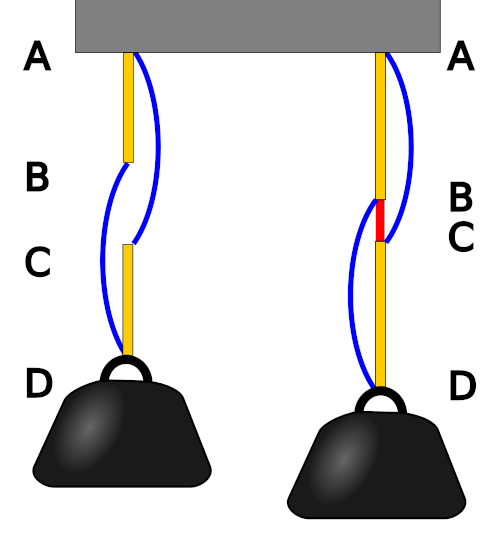The sum of 2k – 4
From one to thirteen plus a score,
Over eleven,
Plus eighteen times seven,
Equals six cubed and not a bit more.
(Will Nediger, “Can Math Limericks Survive?”, Word Ways 37:3 [August 2004], 238.)
The sum of 2k – 4
From one to thirteen plus a score,
Over eleven,
Plus eighteen times seven,
Equals six cubed and not a bit more.
(Will Nediger, “Can Math Limericks Survive?”, Word Ways 37:3 [August 2004], 238.)
In his Canterbury Puzzles of 1907, Henry Dudeney posed a now-famous challenge: How can you cut an equilateral triangle into four pieces that can be reassembled to form a perfect square?
Dudeney’s beautiful solution was accompanied by a rather involved geometric derivation. It seems unlikely that he worked this out laboriously in approaching an answer to the problem, but how then did he reach it?
Here’s one possibility: If a strip of squares is draped adroitly over a strip of triangles, their intersection forms a wordless proof of the task’s feasibility:

Whether that was Dudeney’s path to the solution is not known, but it appears at least plausible.

Here’s an oddity: In the figure on the right, a weight is suspended by two springs (AB and CD) connected by a short length of inelastic rope (BC). The blue curves are lengths of string, which are slack here.
Surprisingly, when the rope is cut, the weight rises (left). Why? In the initial state the springs were arranged “in series,” one above the other. When the rope is cut, the blue strings go taut, and now the two springs are arranged “in parallel,” working together and thus more effective in resisting the weight’s pull.
3 and 5 are “twin primes”: They’re two prime numbers that differ by 2. Further such pairs are 5 and 7, and 11 and 13. These pairs get sparser as you travel out the number line, but no one knows whether they eventually cease appearing altogether.
University of Alberta mathematician Leo Moser saw an opportunity in this pattern — if a prime magic square can be fashioned from the smaller partners in these pairs:
29 1061 179 227 269 137 1019 71 1049 101 239 107 149 197 59 1091
… then it immediately suggests a second prime square produced from the larger:
31 1063 181 229 271 139 1021 73 1051 103 241 109 151 199 61 1093
(“Strictly for Squares,” Recreational Mathematics Magazine 1:5 [October 1961].)

Draw a pentagram and enclose its arms in circles as shown. Each pair of adjoining circles will intersect at two points, one at a juncture of the pentagram’s arms. The second points of intersection will lie on a circle.
The converse is true if the centers of the five circles lie on that implied (red) circle (below): The lines connecting the second intersection points of neighboring circles will describe a pentagram whose outer vertices fall on the circles.
Discovered by Auguste Miquel.

[T]o the human mind there is more to blood than its mere chemical content. … For example, blood must essentially be thicker than water, impossible to get out of stones, indelible in its staining. … When apparent on heads, it should leave them unbowed; and should have the capacities to combine formidably with toil, tears and sweat and to attain boiling-point when its host faces frustration.
— Patrick Ryan, in New Scientist

An inquisitive ant sets out from point A at a bottom vertex of the 1 × 1 × 2 box shown above. Of all the possible destinations it might seek in a direct route along the surface of the box, which one requires the longest journey?
Intuitively we might think it’s point B, the farthest vertex on the box roof. But Japanese mathematician Yoshiyuki Kotani discovered that the longest journey actually ends one-fourth of the way along the rooftop diagonal that ends at point B.
This can be seen by “unfolding” the box into a flat diagram, where four different paths can be traced from A to that point. The Pythagorean theorem shows that all four paths have the same length, 2.850…, which is about 0.022 longer than the shortest path to B.
Data scientist Shiro Matsumoto provides some animations here.
(Martin Gardner, “The Ant on a 1 × 1 × 2,” Math Horizons 3:3 [February 1996], 8-9.)

Make an inverted triangle of hexagonal cells with side length 3n + 1, and color the cells in the top row randomly in three colors. Now color the cells in the second row according to these rules:
When you’ve finished the second row, continue through the succeeding ones, applying the same rules. Pleasingly, no matter how large the triangle, the color of the last cell can be predicted at the start: Just apply our two guiding rules to the endmost cells in the top row. If those two cells are both red, the last cell will be red. If one is red and one is yellow (as in the figure above), the bottom cell will be blue.
The principle was discovered by Newcastle University mathematician Steve Humble in 2012. Gary Antonick gives more background here, and see the paper below for a mathematical discussion by Humble and Ehrhard Behrends.
(Ehrhard Behrends and Steve Humble, “Triangle Mysteries,” Mathematical Intelligencer 35:2 [June 2013], 10-15.)